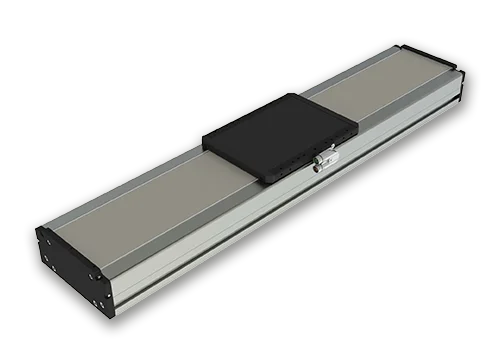Hi mechatronics fans!
Welcome to this new post in our Sinadrives blog.
June 2024
In this edition, we will discuss linear modules with linear motors. It seems that everyone is familiar with modules, but based on our experience and customer inquiries, we have observed that in many cases, customers are unaware of the advantages this solution can offer. We will explain the different technologies available on the market, how to use them properly, and most importantly, how to avoid common mistakes. Today, the mechatronics engineer can draw some conclusions about the types of linear modules that exist and when it is advisable to use them.
Starting point
Under the term “linear module with integrated linear motor,” we understand a pre-assembled electromechanical set, a Plug & Play solution ready for integration into the machine. The linear module with integrated linear motor consists of a base profile, linear guides, linear motor, linear encoder, movable carriage with connector, and end stops with dampers. All components are assembled and verified. The linear module has passed a functionality test and meets the technical specifications indicated in the catalog.

What types of linear modules are available on the market? How do linear modules differ?
To divide linear modules into groups, there are several main characteristics such as precision, dynamics, or type of application. There are actually a multitude of criteria, which are:
Type of module base
The module base can be made of granite, steel, machined aluminum, carbon fiber, or extruded aluminum. Granite bases are used in applications requiring precision or thermal stability, steel bases for heavy load applications, machined aluminum for precision applications, carbon fiber for dynamic applications, and extruded aluminum for automation applications (focused on dynamics rather than precision).
Type of guiding or linear guides
When it comes to linear motors, the guides commonly used are ball recirculation guides, crossed roller guides, or air bearings. The latter are used in test machines with short travel but high dynamics and in metrology applications.
Type of Linear Motor
We can divide linear modules according to the type of linear motor, such as ironcore (with iron core) linear motor, ironless (without iron core) linear motor, and tubular motor.
Type of Encoder
Almost all available technologies are used in linear modules, such as optical encoders for high-precision applications, inductive encoders for dirty environments, and magnetic encoders for low-cost applications. Encoders are divided into two main groups: incremental encoders and absolute encoders. Additionally, there is the possibility of adding functional safety features to comply with EN 61508 standards.
Type of application
We are talking about specific applications. For example, applications in vacuum or water environments require the use of very different materials and components.
Size and load capacity
We can categorize linear modules by their load capacity, ranging from a few grams to handling considerable weights. In this case, the size of the shaft changes and the design must be more robust.
Protections
There are a multitude of solutions for environments with dirt, dust, water, and other contaminants.
How to select an appropriate linear module for each application?
The selection of a linear module begins by gathering application data. This includes the dynamic profile and description of the required movement, weight or load to be moved, levers or reaction arms, the position of the load’s center of gravity, useful travel, environmental conditions and temperature, desired encoder type, communication protocol, and the model of servodrives used.
Calculations are then performed for static and dynamic loads, motor force and current consumption, thermal simulation of the motor cycle, static and dynamic deflection, lifespan, natural frequency calculations, FEM simulations, etc. Based on this data, the appropriate linear module with the optimal motor and encoder type for each application is selected.
What features of my machine can be improved with the use of Direct Drive technology (linear motor)?
There are numerous performance enhancements that can be achieved with Direct Drive technology (linear motor). Notable improvements include better dynamics and speed (as well as acceleration and jerk), increased productivity, enhanced dynamic behavior of a moving axis, reduction of resonances and vibrations, shorter stabilization time, reduced maintenance and breakdowns (increasing machine availability), reduced installation space, and extended useful travel.
Additionally, this technology simplifies mechanical design by using fewer mechanical components, thus reducing design and assembly time.
What should I avoid or which applications are not recommended for linear motor modules?
All high-temperature applications (above 70-80ºC), applications in the food industry that require washing with high-temperature detergents, applications with magnetic dust in suspension, and vertical applications with loads exceeding 30 kg are not recommended for this type of technology.
Let us analyze your application and, if it fits within our power range, we will provide you with a demonstration unit for a complete test. This will be done within your company, using your usual electronics, and with the support of our experts. This way, we ensure everything fits perfectly before starting the new design.
Summary:
There are several types of linear modules, adapted to different applications. The bases can be made of granite, steel, machined aluminum, carbon fiber, or extruded aluminum, each with specific advantages in precision and load capacity. The guiding systems include ball guides, crossed roller guides, and air bearings, while the motors can be ironcore, ironless, or tubular. The encoders can be optical, inductive, or magnetic, and can be incremental or absolute.
To select the appropriate module, application data must be considered and calculations and simulations performed. Direct Drive technology improves dynamics, speed, and reduces maintenance, but is not suitable for high temperatures, certain food industry environments, magnetic dust, and vertical applications with heavy loads. If you want to know which types of linear modules are most suitable for your machine, request assistance from the SINADRIVES team.






Get Social